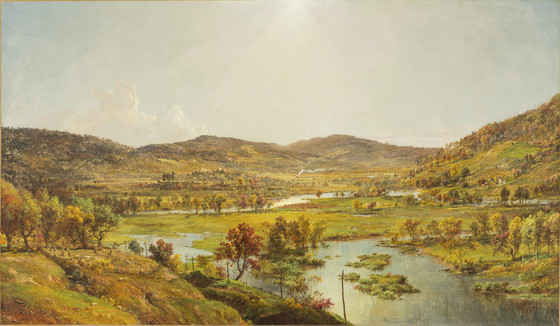Sidney Plains is an area in south-central New York State, between Binghamton and Oneonta, that Cropsey visited frequently on his trips to Niagara Falls and the Susquehanna River Valley....
Sidney Plains is an area in south-central New York State, between Binghamton and Oneonta, that Cropsey visited frequently on his trips to Niagara Falls and the Susquehanna River Valley. In the middle ground, at the extreme right, just below the hill with the white farmhouse flows the Unadilla River. A pencil drawing dated 1873 locates the exact spot Cropsey chose to delineate. In fact, the painting deviates little from the preparatory drawing and consequently takes on the character of a topographical record. It was just such numerous details presented on a large scale that critics such as Henry James found fault with when the painting was exhibited at the annual exhibition of the National Academy of Design in 1875.
During the eleven years following his return from England in 1863, Cropsey added to his growing reputation with a number of largescale, panoramic landscapes of northeastern American scenery. In Sidney Plains, as in the earlier Valley of Wyoming, 1865 (Metropolitan Museum of Art, New York), he attempted to epitomize the settling of the wilderness. Cropsey depicted man’s encroaching on the wild landscape as he fenced in orchards and grazing fields for cows and sheep. Such expansion was then seen as "progress" and was associated with the advancement of modern technology, here indicated by the presence of telegraph poles and a distant train. The completion of the Erie Railroad line to Binghamton through the Alleghenies in 1848 had made the area more accessible to New York City.
Cropsey’s landscape represents a nostalgic image of the settling of the American frontier. The railroad was crucial to the settlement of the American wilderness and in this painting may have had more than iconographic significance. Cropsey may have painted Sidney Plains for the railroad magnate John Taylor Johnston. There is conflicting information concerning the name of the original owner: when the landscape was exhibited at the National Academy of Design in 1875, the owner was listed as John H. Johnston, and literature thereafter referred to the owner as John N. Johnston or John J. Johnston. John T. Johnston was a collector of American painting and the first president of the Metropolitan Museum of Art. If he were the owner, Sidney Plains was not sold in 1876 when business circumstances forced him to sell much of his collection. John T. Johnston may have kept the painting or given it to his son, John Herbert Johnston, owner of the Tenth Street Studio Building, where many New York artists rented studios. Although John Taylor Johnston did not own the Erie Railroad pictured in Cropsey’s landscape, his Lehigh and Susquehanna line provided one of the links from the seaboard to the inland.
Sidney Plains is painted in Cropsey’s characteristic autumnal palette, which, according to the color notes written on the preparatory drawing, he found in nature. The sun breaking through the moist haze has the appearance of shafts of light. Although they can be explained as a natural phenomenon, these pearly hued rays imply a divine blessing on the land and its settlement.
More...



